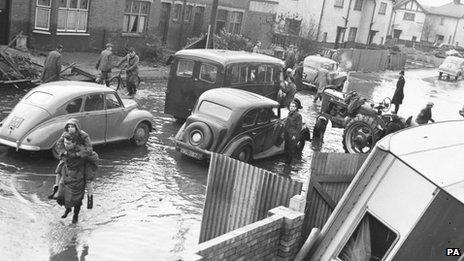East coast floods: Environment Agency anniversary warning
- Published

King's Lynn in Norfolk was among the towns devastated by the 1953 floods
Sixty years on from the 1953 east coast floods, one in 25 homes in England and Wales is at risk of coastal flooding, the Environment Agency has warned.
More than 300 people were killed and 30,000 homes evacuated as more than 1,000 miles of British coast was affected by the storm.
The agency said, despite improvements in warnings and defences, flooding along the coast remained a real threat.
Climate change was likely to exacerbate the situation, the agency added.
The flooding, which began on the night of 31 January, was caused by a combination of a high spring tide, deep atmospheric low pressure which raised sea levels and exceptionally strong northerly gales, which led to a surge of sea water over coastal defences.
The floods were a catalyst for major flood defence investment, including defences at Jaywick, Essex, which protected 2,600 properties.
'Huge improvements'
Other projects included a £6m scheme at Canvey Island and a beach replenishment programme to bolster 12 miles (20km) of flood defences along the Lincolnshire coast, protecting more than 23,000 homes.
In the last 10 years more than £250m has been spent on coastal defences in Lincolnshire, Norfolk, Suffolk and Essex.
David Rooke, the Environment Agency's director of flood and coastal risk management, said the anniversary should serve as a reminder of the devastation flooding could cause to lives and property.
He said: "Since 1953 huge improvements have been made in flood forecasting and prevention.
"But 1.3 million people are at risk of coastal flooding in England and Wales and this is set to increase with a changing climate and rising sea levels.
"The extra protection and reassurance flood defences give to many communities should not be under-estimated but nor should the reality that tidal surges along the coast still happen regularly.
"We cannot afford to be complacent and the experiences in the United States during Hurricane Sandy should make us pause and reflect on the destructive power of a major coastal surge."
Much of the investment has been focused upon areas where there was major loss of life in 1953.
The Environment Agency said improvements in flood forecasting, including the use of tide, wave and weather data, meant businesses and emergency responders were now better prepared.
Some 1.2 million people are signed up to the agency's automated flood alerts.
The Country Land and Business Association (CLA) said many of the walls protecting the coast were now in need of major maintenance.
Tim Woodward, CLA East rural adviser, said: "It would be foolish of us to believe nothing like the horror of six decades ago could happen again.
"I think we have to accept that it may be uneconomic for the government and local authorities to maintain coastal defences to the extent that they have in the past.
"However, projects often appear not to be viable because financial tests fail to take into account the true value of farmland, rural communities and the need for food and economic security."
The CLA is lobbying for a review of coastal defence policy for rural areas, which might include cutting red tape to make it easier for landowners to apply to maintain their own defences.
- Published28 January 2013
- Published12 January 2013
- Published9 December 2012
- Published8 November 2012